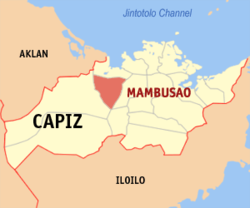Mambusao
Mambusao | |
|---|---|
| Municipality of Mambusao | |
 Map of Capiz with Mambusao highlighted | |
Location within the Philippines | |
| Coordinates: 11°25′48″N 122°35′43″E / 11.43°N 122.5953°E | |
| Country | |
| Region | Western Visayas |
| Province | Capiz |
| District | 2nd district of Capiz |
| Barangays | 26 (see Barangays) |
| Government | |
| • Type | Sangguniang Bayan |
| • mayor of Mambusao[*] | Leodegario A. Labao Jr. |
| • Electorate | 28,567 voters (2022) |
| Area | |
| • Total | 136.91 km2 (52.86 sq mi) |
| Population (2020 census)[3] | |
| • Total | 40,690 |
| • Density | 300/km2 (770/sq mi) |
| Time zone | UTC+8 (PST) |
| ZIP code | 5807 |
| PSGC | |
| IDD : area code | +63 (0)36 |
| Income class | 3rd municipal income class |
| Revenue (₱) | ₱ 150.3 million (2020), 66.65 million (2012), 72.09 million (2013), 82.13 million (2014), 91.98 million (2015), 101.5 million (2016), 114.6 million (2017), 122.9 million (2018), 134.6 million (2019), 160.2 million (2021), 212.2 million (2022) |
| Native languages | Capisnon Hiligaynon Tagalog |
Mambusao, officially the Municipality of Mambusao, is a 3rd class municipality in the province of Capiz, Philippines. According to the 2020 census, it has a population of 40,690 people.[3]
It is 36 kilometres (22 mi) from Roxas City.
Its economy is based on agriculture with rice and coconut as the primary products and crops. The annual festival of Mambusao is called "Inilusan" honoring of St. Catherine of Alexandria, the patron saint of the town, celebrated every November 25. Inilusan literally means sharing of dish by neighbors.
Mambusao is the home of the Villareal family, the most famous of whom is Speaker Cornelio "Agurang Coni" Villareal and Governor Cornelio "Dodoy" Villareal. It is also the birthplace of the late Filipino diplomat and politician Roy Señeres.
Barangays
Mambusao is politically subdivided into 26 barangays. [2]
- Atiplo
- Balat-an
- Balit
- Batiano
- Bating
- Bato Bato
- Baye
- Bergante
- Bunga
- Bula
- Bungsi
- Burias
- Caidquid
- Cala-agus
- Libo-o
- Manibad
- Maralag
- Najus-an
- Pangpang Norte
- Pangpang Sur
- Pinay
- Poblacion Proper
- Poblacion Tabuc
- Sinondojan
- Tugas
- Tumalalud
Demographics
| Year | Pop. | ±% p.a. |
|---|---|---|
| 1903 | 8,225 | — |
| 1918 | 11,913 | +2.50% |
| 1939 | 15,723 | +1.33% |
| 1948 | 18,619 | +1.90% |
| 1960 | 19,504 | +0.39% |
| 1970 | 24,530 | +2.32% |
| 1975 | 28,129 | +2.78% |
| 1980 | 32,097 | +2.67% |
| 1990 | 33,213 | +0.34% |
| 1995 | 35,632 | +1.33% |
| 2000 | 36,793 | +0.69% |
| 2007 | 37,498 | +0.26% |
| 2010 | 37,672 | +0.17% |
| 2015 | 39,644 | +0.98% |
| Source: Philippine Statistics Authority[4][5][6][7] | ||
In the 2020 census, the population of Mambusao was 40,690 people,[3] with a density of 300 inhabitants per square kilometre or 780 inhabitants per square mile.
References
- ^ Municipality of Mambusao | (DILG)
- ^ a b "Province: Capiz". PSGC Interactive. Quezon City, Philippines: Philippine Statistics Authority. Retrieved 12 November 2016.
- ^ a b c Census of Population (2020). "Region VI (Western Visayas)". Total Population by Province, City, Municipality and Barangay. Philippine Statistics Authority. Retrieved 8 July 2021.
- ^ Census of Population (2015). "Region VI (Western Visayas)". Total Population by Province, City, Municipality and Barangay. Philippine Statistics Authority. Retrieved 20 June 2016.
- ^ Census of Population and Housing (2010). "Region VI (Western Visayas)" (PDF). Total Population by Province, City, Municipality and Barangay. National Statistics Office. Retrieved 29 June 2016.
- ^ Censuses of Population (1903–2007). "Region VI (Western Visayas)". Table 1. Population Enumerated in Various Censuses by Province/Highly Urbanized City: 1903 to 2007. National Statistics Office.
- ^ "Province of Capiz". Municipality Population Data. Local Water Utilities Administration Research Division. Retrieved 17 December 2016.
External links

